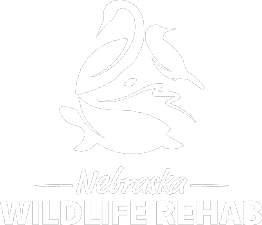
You might watch the video below and ask yourself... what the heck is going on? What seems like a scene from the Hundred Acre Wood is trail camera footage from a soft release involving three juvenile foxes that came into our care last summer after being orphaned and needing supportive care until they were old enough to be on their own. During this period, they spent significant time in an outdoor pre-release enclosure before we allowed them to leave at their own pace. Our team provided food for them until we were sure they could hunt on their own and fend for themselves. Trail cameras are often used to monitor the feeding and weaning process, giving us good insight into the status of our patients (and a very entertaining glimpse into the lives of our other wild neighbors as well).
When it comes to releasing rehabilitated animals back into their natural habitats, wildlife rehabilitators face the decision between soft release and hard release methods. Both approaches have their merits and drawbacks, and finding the right balance is essential for ensuring the successful reintegration of animals into the wild. Soft release involves a gradual and controlled introduction of rehabilitated animals to their natural environment. Compared to hard release, this method allows animals to acclimate to their surroundings, giving them time to regain strength, continue to develop natural behaviors, and establish territory before full independence. It often involves providing supplemental food and shelter during the transition period.
One big advantage of soft release is that it allows animals to relearn essential survival skills at their own pace, reducing the risk of immediate threats and improving their chances of long-term survival. Additionally, animals can adjust to the changing environment at a pace that suits their physical and psychological needs, leading to a smoother transition back into the wild. It gives us an opportunity to closely monitor the released animals and provide ongoing support and intervention if needed. Avoiding the risk of dependency on human-provided resources is top of mind for rehabilitators during this process. The goal is to ensure the animal's ability to forage independently, so over time, the support we give them gradually decreases and then stops all together once they’ve shown they are succeeding on their own.
Whenever possible, we will choose to soft release young mammals, especially those that need to perfect their hunting or nesting skills. With adult mammals and other adult animals, like turtles or birds, we do our best to return them to the territory they came from. If that’s not possible, we choose optimal habitat in which they can thrive. In Nebraska and many other states, it is illegal to move an animal far from its original territory (i.e. trap and relocate). Studies show that hard relocation is also hard on wildlife, with the majority of relocated adult mammals dying within a short time of their relocation.
Compared to the slow and steady aspects of soft release, the quick reintegration of hard release methods allows for a swift return to the wild, minimizing the time spent in captivity and reducing the risk of habituation to humans. Animals released via the hard release method rely on their instincts immediately, potentially leading to a more natural reintegration. However, because animals may experience stress and disorientation due to the abrupt change from captivity to the wild, potentially putting them at risk if they “run scared,” this is not an option for all our patients. Hard releases make the most sense when an adult animal with an established territory is only in rehabilitation for a short period of time and can be returned directly to its territory. For those animals, it’s just like going home, and the best way for them to return to nature. Hard release does make post-release monitoring challenging without the aid of radio- or GPS-tracking, which hinders our ability to provide necessary support or intervention. For that reason, we continue to grow our resources so that hard release is only used when it’s in the best interest of our wild patients.
The decision between soft release and hard release is not one-size-fits-all and should be made on a case-by-case basis. Factors such as species, individual health, behavior, and environmental conditions must be carefully considered. Striking the right balance between the benefits of soft release and the efficiency of hard release is essential for the success of wildlife rehabilitation efforts.

